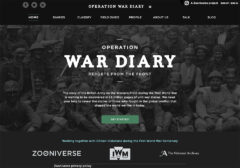Digital public history has a history of its own, which correlates with the development of online media over the past two decades. This became clear to me during an assignment in a course on digital public history at George Mason University. The assignment required examining 11 different digital history projects created from 1998-2014.
In his 1996 book Creating Killer Web Sites: The Art of Third-Generation Site Design, David Siegel outlined three different phases of website development.1 The first generation sites were essentially text-based, harnessing the basic functionality of Hypertext Markup Language (HTML) in its early stages. Second generation sites introduced graphics for illustration and navigation, and designers found that the table tag allowed them great control over the structure of web pages. Third generation sites, which were becoming increasingly popular at the time Siegel’s book was published, exhibited a maturity of thought about communicative purpose and the role of design in achieving it.
Of course, websites have developed further by refining the relationship between HTML and Cascading Style Sheets, embracing Web 2.0 interactions, and widely adopting Responsive Web Design.

For example, the Library of Congress site Progress of a People is a digital exhibit created in 1998. It allows visitors to explore a collection of pamphlets that reveal aspects of African American history. The site is clearly a second generation product, built using tables. In contrast, Operation War Diary is assembled using modern standards of web design. Created in 2014, it goes beyond what would be expected from a third generation website. While the website is not responsive, it does offer readers a rich online experience.
The two projects also show how the approach to digital public history has changed. “Progress of a People” is an exhibit in which readers take a largely passive role. “Operation War Diary” calls on readers to become “citizen historians” by working with primary documents and helping academics advance research.
Good quality digital public history projects need to clearly define their purpose and audience. An online exhibit that does not require much of the reader is perfectly acceptable if that is what its creators wish to accomplish. On the other hand, a project that attempts to do too much or whose intentions are not clear may fail.
A growing number of users gain access to the internet through mobile devices, so it is important that digital public history projects pay attention to where their public(s) can be found. Some recent efforts have done so with success, such as Histories of the National Mall or the New York Public Library’s Building Inspector. The National Mall project views its primary audience as a public that is physically on the mall in Washington, D.C., and therefore mobile. The library’s project seeks the public’s assistance in verifying information gleaned from New York City insurance maps through an interface that is simple and even entertaining.
Through reviewing two decades of digital history projects it also becomes evident that “future-proofing” must be a consideration. If funding for a project runs out, who will maintain it? Or should a digital project that has outlived its funding be released to the community as an “open source” endeavor?
1. David Siegel, Creating Killer Web Sites: The Art of Third-Generation Site Design (Indianapolis: Hayden Books, 1996).
Accessed on 25 Apr 2024.
The article may be found online at https://straumanis.com/2017/public-history-design/.
